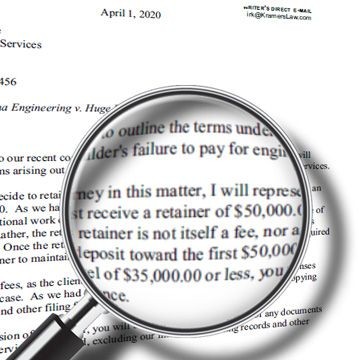The Lawyer's Lawyer
Profiting from Retainers
Q. Unhappy with my client's engineering work, a huge contractor ignored my demand for payment of a $150,000 bill. It's a small sum to the contractor, but a lot of money for my client to lose. With more documents than cash on hand, my client wants to sue and fight "on principle." How should I engineer this?
A. Your client may litigate as a matter of "principle." But if you want to get paid, you must focus on "principal and interest."
With a large number of documents, allegedly negligent engineering services, and a defendant with far greater resources, things could get expensive. Unless you're foolish enough to assume all risk by taking the case on contingency, a client that has already lost $150,000 could lose even more in hourly fees, litigation costs, and a potential counterclaim.
Lawsuits are harder to ignore than demand letters, so it's possible that filing suit may prompt more productive negotiations. But it may not.
One should never embark on litigation on the belief that the case will settle early, easily or cheaply. Like any big investment, litigation is a risky proposition. Before clients invest in a lawsuit, they must consider the following risks:
➤ Lack of Control - once you embark on litigation, you have entered an unpredictable world that revolves at its own pace and may easily veer off course. You can shape your own strategy, but you cannot control the tactics of your adversary. This will affect the actual time you will need to spend on the case and the duration of the litigation itself;
➤ Unpredictable Budgets - just as you cannot control the time it will take to litigate this dispute, you cannot predict what it may cost in the end. A client who insists on a precise budget for complex litigation will be impossible to satisfy;
➤ Counterclaims - where, as here, the contractor is unhappy with your client's engineering services, an action to collect on this bill could trigger a counterclaim for damages arising from any alleged negligence. Even if your client prevails, the cost of litigating complicated engineering issues could easily exceed the amount of your original claim;
➤ The Risk of Losing - no matter how much evidence your client may have, few cases are "slam dunks." No matter how much your client spends on you, your experts and other litigation costs, no one can guarantee that the client will win, how much the client will win, or whether a future award will be worth the investment required to get there. Unless provided by contract or by some sort of fee-shifting statute, your client will bear its own attorney's fees and costs regardless of the outcome. So, even if you win in court, your client may still lose money.
To avoid misunderstandings later on, you should reduce this advice to writing in a retainer agreement which limits the scope of your representation to proceedings before the trial court.But no matter how you express it, actions speak louder than words. Rather than postpone a tense discussion over litigation expense, your fee agreement should require a substantial financial commitment up front. In addition to a sizable deposit toward initial fees and expenses, the agreement must require that the client replenish this "evergreen" retainer periodically to leave sufficient funds in escrow as security for future bills. To give you sufficient time to withdraw from a case that your client may fail to fund in the future, at least 120 days before trial, your agreement should provide for a "balloon" retainer approximating the cost through trial. If you don't get it well in advance, you could get stuck trying a case for which you will never be paid in full.
If your client isn't willing to put his money where his mouth is, why would you be willing to invest your time? As a matter of "principle," focus on "principal and interest." Unless you get the "principal" up front, you cannot protect your interests and should just say "no."
